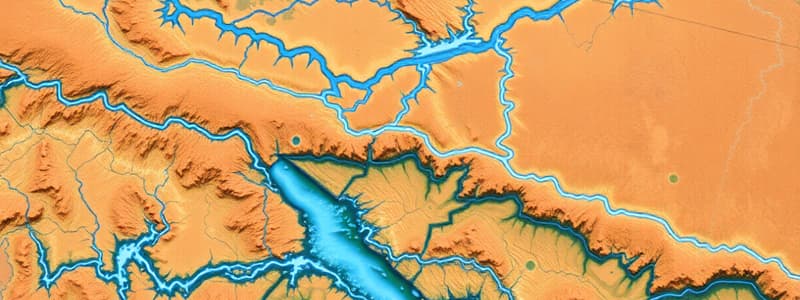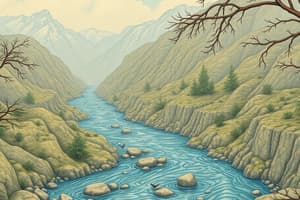Podcast
Questions and Answers
What are the two major rivers originating from the Himalayas?
What are the two major rivers originating from the Himalayas?
The Indus and the Brahmaputra.
What geological features do the Himalayan rivers create as they cut through the mountains?
What geological features do the Himalayan rivers create as they cut through the mountains?
They create gorges.
What kind of geological activity do the Himalayan rivers perform in their upper courses?
What kind of geological activity do the Himalayan rivers perform in their upper courses?
Intensive erosional activity.
Which river has the largest drainage basin in India?
Which river has the largest drainage basin in India?
Where does the Indus River begin its journey?
Where does the Indus River begin its journey?
What features do the Himalayan rivers form in their middle and lower courses?
What features do the Himalayan rivers form in their middle and lower courses?
What is a river system?
What is a river system?
What is a water divide and can you provide an example?
What is a water divide and can you provide an example?
Which river basin is considered the largest in India?
Which river basin is considered the largest in India?
Where do the rivers Indus and Ganga have their origins?
Where do the rivers Indus and Ganga have their origins?
What are the two headstreams of the Ganga, and where do they meet?
What are the two headstreams of the Ganga, and where do they meet?
What are some economic benefits derived from rivers and lakes?
What are some economic benefits derived from rivers and lakes?
Which states do the Mahanadi and Godavari rivers flow through?
Which states do the Mahanadi and Godavari rivers flow through?
What distinguishes the Godavari River among the peninsular rivers?
What distinguishes the Godavari River among the peninsular rivers?
What is the length of the Narmada River?
What is the length of the Narmada River?
Where does the Kaveri River drain?
Where does the Kaveri River drain?
What are the notable features of the Narmada River?
What are the notable features of the Narmada River?
How long is the Mahanadi River?
How long is the Mahanadi River?
Which states are included in the drainage basin of the Godavari?
Which states are included in the drainage basin of the Godavari?
What is the significance of the term 'Dakshin Ganga' in relation to the Godavari?
What is the significance of the term 'Dakshin Ganga' in relation to the Godavari?
What kind of estuaries do the Narmada and Tapi Rivers create?
What kind of estuaries do the Narmada and Tapi Rivers create?
Name two tributaries of the Godavari River.
Name two tributaries of the Godavari River.
What type of lake is the Sambhar lake in Rajasthan?
What type of lake is the Sambhar lake in Rajasthan?
What is the primary characteristic of most freshwater lakes in India?
What is the primary characteristic of most freshwater lakes in India?
Name one reason for the formation of the Wular lake.
Name one reason for the formation of the Wular lake.
What percentage of the world's surface is covered with saltwater?
What percentage of the world's surface is covered with saltwater?
What are some recreational activities enjoyed at lakes in Kashmir?
What are some recreational activities enjoyed at lakes in Kashmir?
What two lakes are mentioned as important in addition to the Wular lake?
What two lakes are mentioned as important in addition to the Wular lake?
What significant plan was launched in 1985 for river cleaning in India?
What significant plan was launched in 1985 for river cleaning in India?
How has hydel power generation contributed to lake formation?
How has hydel power generation contributed to lake formation?
List any two smaller rivers flowing towards the east in India.
List any two smaller rivers flowing towards the east in India.
What does the term 'glacial origin' imply about the lakes in the Himalayan region?
What does the term 'glacial origin' imply about the lakes in the Himalayan region?
What is the significance of the Ganga river's tributaries, such as the Ghaghara, Gandak, and Kosi?
What is the significance of the Ganga river's tributaries, such as the Ghaghara, Gandak, and Kosi?
Describe the slope of the plains from Ambala to the Sunderban.
Describe the slope of the plains from Ambala to the Sunderban.
What is the Namami Gange Programme and its main objectives?
What is the Namami Gange Programme and its main objectives?
Where does the Brahmaputra river originate and how does its course differ from that of the Indus?
Where does the Brahmaputra river originate and how does its course differ from that of the Indus?
Name some tributaries that join the Brahmaputra after it enters India.
Name some tributaries that join the Brahmaputra after it enters India.
What is the alternate name for the Brahmaputra river in Tibet and Bangladesh?
What is the alternate name for the Brahmaputra river in Tibet and Bangladesh?
How do the rivers rising in semi-arid areas, like the Chambal, Betwa, and Son, compare to those from the Himalayas?
How do the rivers rising in semi-arid areas, like the Chambal, Betwa, and Son, compare to those from the Himalayas?
What is the impact of the Ganga river system on agriculture in northern plains?
What is the impact of the Ganga river system on agriculture in northern plains?
Explain the geographical journey of the Brahmaputra from its source to Assam.
Explain the geographical journey of the Brahmaputra from its source to Assam.
Flashcards
Himalayan Rivers: Origin and Gorges
Himalayan Rivers: Origin and Gorges
The Indus and Brahmaputra rivers originate in the north of the Himalayas and carve deep valleys known as gorges.
Major Himalayan Rivers
Major Himalayan Rivers
The Indus, Ganga, and Brahmaputra are major rivers of the Himalayan region, known for their long courses and numerous tributaries.
River System
River System
A river system includes the main river and its tributaries, all working together to drain an area.
Erosion in Himalayan River Upper Courses
Erosion in Himalayan River Upper Courses
Signup and view all the flashcards
Depositional Features in Himalayan Rivers
Depositional Features in Himalayan Rivers
Signup and view all the flashcards
The Indus River System: Origin and Tributaries
The Indus River System: Origin and Tributaries
Signup and view all the flashcards
Largest Drainage Basin
Largest Drainage Basin
Signup and view all the flashcards
Ganga River
Ganga River
Signup and view all the flashcards
Ganga River System
Ganga River System
Signup and view all the flashcards
Tributaries of the Ganga
Tributaries of the Ganga
Signup and view all the flashcards
Northern Tributaries of the Ganga
Northern Tributaries of the Ganga
Signup and view all the flashcards
Southern Tributaries of the Ganga
Southern Tributaries of the Ganga
Signup and view all the flashcards
Brahmaputra River
Brahmaputra River
Signup and view all the flashcards
Namami Gange Programme
Namami Gange Programme
Signup and view all the flashcards
River Meandering
River Meandering
Signup and view all the flashcards
Water Divide
Water Divide
Signup and view all the flashcards
Godavari River
Godavari River
Signup and view all the flashcards
Mahanadi River
Mahanadi River
Signup and view all the flashcards
Narmada River
Narmada River
Signup and view all the flashcards
Drainage Basin
Drainage Basin
Signup and view all the flashcards
Estuary
Estuary
Signup and view all the flashcards
Delta
Delta
Signup and view all the flashcards
Godavari Basin
Godavari Basin
Signup and view all the flashcards
Mahanadi Basin
Mahanadi Basin
Signup and view all the flashcards
Narmada Basin
Narmada Basin
Signup and view all the flashcards
Faulting
Faulting
Signup and view all the flashcards
What is a lake?
What is a lake?
Signup and view all the flashcards
How are natural and artificial lakes different?
How are natural and artificial lakes different?
Signup and view all the flashcards
What is the Sambhar Lake known for?
What is the Sambhar Lake known for?
Signup and view all the flashcards
Where are most freshwater lakes in India located?
Where are most freshwater lakes in India located?
Signup and view all the flashcards
What is unique about the Wular Lake in India?
What is unique about the Wular Lake in India?
Signup and view all the flashcards
For what is the Dal Lake in Kashmir famous?
For what is the Dal Lake in Kashmir famous?
Signup and view all the flashcards
What is a benefit of creating artificial lakes?
What is a benefit of creating artificial lakes?
Signup and view all the flashcards
What is an example of an artificial lake created for hydropower?
What is an example of an artificial lake created for hydropower?
Signup and view all the flashcards
What is the Ganga Action Plan (GAP)?
What is the Ganga Action Plan (GAP)?
Signup and view all the flashcards
What is the National River Conservation Plan (NRCP)?
What is the National River Conservation Plan (NRCP)?
Signup and view all the flashcards
What's a water divide?
What's a water divide?
Signup and view all the flashcards
India's biggest river basin?
India's biggest river basin?
Signup and view all the flashcards
Where do the Indus and Ganga start?
Where do the Indus and Ganga start?
Signup and view all the flashcards
The Ganga's beginnings
The Ganga's beginnings
Signup and view all the flashcards
Why less silt in the Brahmaputra's Tibetan part?
Why less silt in the Brahmaputra's Tibetan part?
Signup and view all the flashcards
Study Notes
Drainage Systems in India
- Drainage describes the river system of an area.
- Streams flow together to form a main river.
- The area drained by a single river system is a drainage basin.
- An elevated area, like a mountain or upland, separates drainage basins. This is called a water divide.
- Indian drainage systems are categorized by the physical features of the subcontinent.
- Two main groups exist: Himalayan rivers and Peninsular rivers.
- Himalayan rivers are perennial (flowing year-round) and originate in the mountains, receiving water from rain and melted snow.
- The Indus and Brahmaputra are major Himalayan rivers that carve gorges through the mountains.
- Peninsular rivers are seasonal, with flow depending on rainfall.
- They have shorter courses and originate in the central highlands, flowing towards the west or Bay of Bengal.
- The world’s largest drainage basin is the Amazon river basin.
Himalayan Rivers
- The Indus, Ganga, and Brahmaputra are major Himalayan rivers.
- These rivers have many large tributaries.
- The Indus rises in Tibet, flowing west through India to the Arabian Sea.
- The Ganga rises in the Himalayas, flowing east to the Bay of Bengal.
- The Brahmaputra originates in Tibet, flowing east through India and joining the Ganga before merging in Bangladesh into the Bay of Bengal.
Peninsular Rivers
- Peninsular rivers primarily rise in the Western Ghats and flow eastward into the Bay of Bengal.
- These include the Godavari, Krishna, Kaveri, Mahanadi, Narmada, and Tapi.
- The Narmada and Tapi are the only major rivers flowing west.
- Many Peninsular rivers are seasonal due to dependence on rainfall.
River Systems
- Tributaries are smaller streams that feed into larger rivers.
- A river system consists of a main river and its tributaries.
Drainage Patterns
- Different rivers have unique drainage patterns affected by the topography and geology.
- Drainage patterns like dendritic, radial, and trellis are influenced by the underlying terrain.
Studying That Suits You
Use AI to generate personalized quizzes and flashcards to suit your learning preferences.




